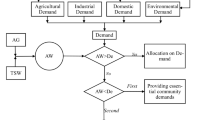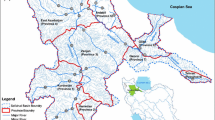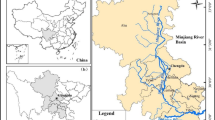Abstract
The allocation of water to the stakeholders of a large basin involves conflicting objectives, since increasing the allocated water to one stakeholder leads to a reduction in water allocated to other stakeholders. The consideration of conflicting objectives is inevitable when the basin is a transboundary basin, where a river crosses at least one political border, either a border within a nation or an international boundary. This paper proposes a multi-objective optimization model for sharing water among stakeholders of a transboundary river, assuming that the stakeholders cooperate. Here, the cooperation implies a balanced water allocation to stakeholders since shortage in each stakeholder have negative impacts on others. Each objective function of the multi-objective model represents the water profit of a stakeholder; which has to be maximized. To reach a cooperative solution, a new method for transforming the multi-objective formulation to a three-step single objective formulation is proposed. The solution guarantees each stakeholder's profit which is larger than a percentage of its highest possible profit obtained in the case when the percentage of profit is equal for all stakeholders. The proposed model formulation was applied to the Sefidrud River where eight provinces are the stakeholders competing for water resources of this basin.






Similar content being viewed by others
References
Ahmadi A, Karamouz M, Moridi A, Han D (2012) Integrated planning of land use and water allocation on a watershed scale considering social and water quality issues. J Water Resour Plan Manag 138:671–681
Ali MK, Klein KK (2014) Implications of current and alternative water allocation policies in the Bow River Sub Basin of Southern Alberta. Agric Water Manag 133:1–11
Anghileri D, Castelletti A, Pianosi F, Soncini-Sessa R, Weber E (2013) Optimizing watershed management by coordinated operation of storing facilities. J Water Resour Plan Manag 139:492–500
Cai X, McKinney DC, Lasdon LS (2002) A framework for sustainability analysis in water resources management and application to the Syr Darya Basin. Water Resour Res 38:211–2114
Divakar L, Babel MS, Perret SR, Gupta AD (2011) Optimal allocation of bulk water supplies to competing use sectors based on economic criterion – An application to the Chao Phraya River Basin, Thailand. J Hydrol 401:22–35
Han Y, Huang Y-F, Wang G-Q, Maqsood I (2011) A multi-objective linear programming model with interval parameters for water resources allocation in Dalian city. Water Resour Manag 25:449–463
Harou JJ, Pulido-Velazquez M, Rosenberg DE, Medellín-Azuara J, Lund JR, Howitt RE (2009) Hydro-economic models: Concepts, design, applications, and future prospects. J Hydrol 375:627–643
Huang Y, Li YP, Chen X, Ma YG (2012) Optimization of the irrigation water resources for agricultural sustainability in Tarim River Basin, China. Agric Water Manag 107:74–85
IBM ILOG CPLEX Optimizer.
Kucukmehmetoglu M, Guldmann J (2010) Multiobjective allocation of transboundary water resources: case of the Euphrates and Tigris. J Water Resour Plan Manag 136:95–105
Kundzewicz ZW (1995) Kindler J (1995) Multiple criteria for evaluation of reliability aspects of water resource systems modelling and management of sustainable basin-scale water resource systems Proc international symposium. Cold Reg Sci Technol 231:217–224
Liu D, Chen X, Lou Z (2010) A model for the optimal allocation of water resources in a saltwater intrusion area: a case study in Pearl river delta in China. Water Resour Manag 24:63–81
McKinney DC, Cai X Multiobjective optimization model for water allocation in the Aral Sea basin. In: 3-rd Joint USA/CIS Joint Conference on Environmental Hydrology and Hydrogeology, 1997. pp 44–48.
MGC (Mahab Ghods Company) (2011) National water master plan study: the Sefidrud Basin. Iranian Ministry of Energy, Tehran
Mostert E (2005) How can international donors promote transboundary water management? German Development Institute, Berlin
Plà LM, Sandars DL, Higgins AJ (2013) A perspective on operational research prospects for agriculture. J Oper Res Soc 65:1078–1089
Rezapour Tabari MM, Yazdi A (2014) Conjunctive use of surface and groundwater with inter-basin transfer approach: case study. Water Resour Manag 27:2965–2988
Roozbahani R, Schreider S, Abbasi B (2013) Economic sharing of basin water resources between competing stakeholders. Water Resour Manag 27:2965–2988
Schlüter M, Savitsky AG, McKinney DC, Lieth H (2005) Optimizing long-term water allocation in the Amudarya River delta: a water management model for ecological impact assessment. Environ Model Softw 20:529–545
Torabi Palatkaleh S, Estiri K, Hafez B (2010a) The role of environmental requirements in process of water allocation for watersheds in Iran: sustainable development approach. Paper presented at the 2nd international conference Water, ecosystems and sustainable development in arid and semi-arid zones, Tehran.
Torabi Palatkaleh S, Roozbahani R, Hobevatan M, Estiri K (2010b) Water allocation regulation. Tehran, Iranian Ministry of Energy
UNESCAP (2000) Principles and practices of water allocation among water-use sectors. United Nations, Economic and Social Commission for Asia and the Pacific, Bangkok, Thailand.
Author information
Authors and Affiliations
Corresponding author
Rights and permissions
About this article
Cite this article
Roozbahani, R., Abbasi, B., Schreider, S. et al. A Multi-objective Approach for Transboundary River Water Allocation. Water Resour Manage 28, 5447–5463 (2014). https://doi.org/10.1007/s11269-014-0812-y
Received:
Accepted:
Published:
Issue Date:
DOI: https://doi.org/10.1007/s11269-014-0812-y




